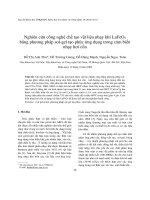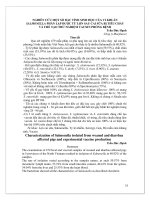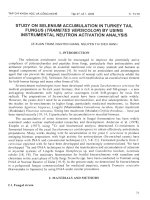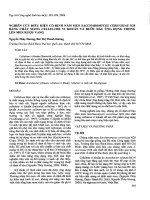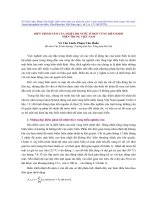Báo cáo " Nghiên cứu tích tụ selenium ở nấm vân chi Trametes versicolor bằng phân tích kích hoạt neutron" pdf
Bạn đang xem bản rút gọn của tài liệu. Xem và tải ngay bản đầy đủ của tài liệu tại đây (370.85 KB, 7 trang )
TAP CHi KHOA HOC
VACONG
NGHE Tap 47, so L 2009 Tr. 73-79
STUDY ON SELENIUM ACCUMULATION IN TURKEY TAIL
FUNGUS {TRAMETES
VERSICOLOR)
BY USING
INSTRUMENTAL NEUTRON ACTIVATION ANALYSIS
LE XUAN THAM, NGUYEN GIANG, NGUYEN THI DIEU HANH
1.
INTRODUCTION
The selenium enrichment would be encouraged to improve the potentially active
complexes of polysaccharides and peptides from fungi, particularly their antioxydative and
antitumor properties. Se plays an essential nutritional role in many animals and humans as
integral components of several enzymes [4]. Se would be an antioxidant and antimutagenic
agent that can prevent the malignant transformation of normal cells and effectively inhibit the
activation of oncogenes [16]. Selenium (Se) is now well established as an essential trace element
for both human beings and many other forms of life.
Se-enrichment technologies have been developed with yeasts Saccharomyces cerevisae for
medical preparations as Se-rich yeast biomass, that is rich in proteins and SH-groups - a new
anti-ageing medicaments with highly active scavengers (with SeH-groups) for toxic free
radicals. The preparations of Se-enriched yeasts have been commercialized quite widely.
However, the yeasts don't need Se as essential micronutritive, and also selenoproteins. In fact,
the studies on Se-enrichments in higher fungi, particularly medicinal mushrooms, i.e. Button
mushroom Agaricus bisporus, Lingzhi (Mannentake) Ganoderma lucidum. Oyster mushroom
(Houbitake) Pleurotus oslreatus. Sitting hen mushroom (Mailake) Grifola fi-ondosa, have just
been started recently [19, 14, 3] particularly for accumulation in mycelial biomass.
The accumulation of some bioactive minerals in fungal fermentation has been widely
examined under nuclear method-aided researches and development. Anderson et al. (1978),
Toepfer et al. (1977) using ''Cr and biochemical analysis determined Cr-enrichment in
fermented biomass of the yeast Saccharomyces carlsbergensis to obtain effectively anti-diabetic
preparations. Many works dealing with Se accumulation in the yeast S. cerevisiae to produce
antiaging biomass preprations with high activity for antioxydation (Se-enriched yeasts) have
used tracer with INAA and conventional techniques [13, 5-8, 21]. Fermented products from S.
cerevisiae enriched with Se have been developped and increasingly commercialized. We have
devdopped ''Se and FNAA techniques to detect the translocation and accumulation of selenium
in mycelial systems of Lingzhi fungus Humphreya sp. and Ganoderma lucidum, Lentinula
edodes [18, 19], The stationary fermentation for fruitful bioenrichments with vanadium and
chromium in the yeast phase of Jelly fungi Tremella spp. have been conducted in Vietnam using
INAA al Nuclear Reactor of Dalai [19. 9]. In the present study we determined Se bioenrichment
in a polyporoid fungus commercialized for medicinal purposes, namely Trametes versicolor
(Kawaratake in Japanese) by using INAA under similar procedures.
2.
MATERIALS AND METHODS
2.1.
Fungal strain
73
The germ of Trametes versicolor supplied from Chiba University, Japan was recloned
(repurified) and collected from Tsukuba region isolated on PDA in Takasaki Radiation
Chemistry Research Establishment, JAEA and fruitfully cultivated in DalaL HoChiMinh City,
Vietnam (Le Xuan Tham et al., 1999), and compared with some native strains collected in
National Park of Cattien and Bidoup - Nui Ba, South Vietnam.
2.2.
Fermentation
Stationary fermentation was maintained at room temperature (33-34°C) during 30 days in
250 ml flasks containing 150 ml of PG solution (without agar), supplemented yeast extractpg/1)
and selenium in NaSeOs at concentration of 10 ppm, prepared from Se source enriched in '''Se as
a target in nuclear reactor for 'Se production.
2.3.
Sampling
Biomass of fermented mycelia was collected at 5, 7, 9, 14, 20, 25 and 30 days after
inoculation. Samples of mycelial biomass were gently washed with HCl 0.1 N and distilled
water for 5 times to eliminated away free Se. then dried at 40°C until constant weight, ground
finely and compressed to form pellets covered with thin PE film for irradiation.
•
I
2.4.
Irradiation
In thermal column of the reactor under neutron fiux appr. lO'^n.cm^s' when reached 500
KW capacity, the samples of pellet were irradiated for 20 hs with standard and blank ones, and
then stored for a week to eliminate some short-lived radionuclides.
2.5.
Measurement and calculation
The irradiated samples were measured and analyzed for Se by a Multichannel y
Spectrometer (Canberra) with HP Ge Detector. The calculations were based on areas of y
standard peaks of 'Se activated (with specific softwares from IAEA).
3.
RESULTS AND DISCUSSION
3.
1. Liquid fermentation of mycelia of Trametes versicolor - E{fecti\e biomass production
Stationary fermentation at room temperature was conducted and continuously maintained
for 30 days for regularly harvesting the mycelial biomass.
Table
1.
Se content in mycelial biomass of Kawaratake in stationary fermentation
supplemented with Se at 10 ppm
Time of incubation (days)
7
10
15
20
25
30
Mycelial biomass growth (g)
0.110
0.220
0.460
0.625
0.639
0.635
Se content (ppm)
1549
1395
868
823
680
678
At earlier stages we have not yet examined the accumulation of Se in so little biomass of
mycelia just fermented.
74
Fruitful cultivation of Kawaratake Trametes versicolor was conducted effectively in Dalat,
Hanoi and HoChiMinh City. However, recovery efficiency of polysaccharides, particularly bio-
active fractions - their main components is not available in practice for materia medica supply.
«J0 1-
m
300
2no
lilt
ji
„F*
0
,"Se .r-y ;. l-!:l;£u^^;'::':
•• ^
*'>s8HHiflHHl£!litti
•
;^«SiB^a&SiPillll
1
^^B^^W'ji II llli ii ll
1
Ihlii'
1
.rt^.tiiaLiMi'L^
^U !^^
., '.^ i:
:
•: j(iKE*-«i?rigi»s^5«tiso»ii;i*i#s'w»'^/^
^
4?M1U
Fig. 1. Spectra of energy of''Se activated in
standard
Fig. 2. Spectrum of gamma ray energy emitted Se
activated in mycelial biomass of Kawaratake
fermented for 10 days without Se supplement
The results have been obtained with Trametes versicolor showing high Se levels in
mycelial biomass up to 600 - 1500 ppm, while in the control (without Se supplement), only trace
of Se (1 ppm more or less) determined by using INAA (Instrumental Neutron Activation
Analysis) in Nuclear Reactor, as shown in Table 1 and Figs. 1, 2, 3. This would be related to the
researches on configurations of complex of polysaccharides and proteins in biomass with high
bioactivities (Hobbs, 2005). Se would substitute S for some due structures and enhance their
bioactivities.
10000 - -
8000 -
6000
>'•>
4000 •
2000 -
- r
264.TkeV
2T9JkeV
J.,:
-]
y
ym^mmm
HF'
'~
'^^^1
-^^^^^^^^R
. iK
teV
r^^f^f^
HtHB?^'
^^^^^Brv
1
i
0 T T'" • " 1 rn .
0
500
1000
ISOO
,).;
'\:X]^||flH
' "''^Jj
'
'
V
h '.T-fyy-^
•^s^.TM^
•^hW
2000
^
1
-
250t
Fig. 3. Spectrum of gamma ray energy emitted from Se enriched and activated in
mycelial biomass of Kawaratake fermented for 10 days with 10 ppm Se supplement
Perfectly consistent with its higher Se-content in Ganoderma lucidum, the protein exhibits
approximately three times stronger activity of scavenging superoxide and hydroxyl radicals as
75
compared to the water-soluble protein extract, a finding demonstrating that the increasing
antioxidant property of this protein depends quantitafively on its Se content [25, 10].
Selenium enrichments in fungal biomass would be promising for novel bioactive
ingredients, due to Se substitutions in many S-containing compounds, particularly in amino
acids containing S, such as cystein, methionine, ; in peptides with disulphide bridges, that
related to configures of many enzymes, proteins, polysaccbarides-proteins complexes, and
free sdenates, but at trace levels.
They would expect some novel potenfials in antioxydative acfivity, antitumor activity,
with Se-rich Kawaratake, Mannentake, Maitake, Houbitake and Shiitake, richest in
Ergothionine! Selenium exerts its biological funcfion in mammalian cell largely through
selenoproteins and selenoenzymes, which contain selenocysteine (Se-Cys), the 21st amino acid,
at the active site. These selenoproteins and selenoenzymes are an essential prerequisite for
normal development and a long and healthy life. In all these selenoproteins, Se is incorporated
into the protein molecule via the selenocysteinyl-tRNA, which recognizes the specific UGA
codons in mRNA to insert selenocysteine into the primary structure of selenoproteins, hi
addition to incorporation as selenocysteine, selenium can replace sulfur in methionine of
prokaryotic proteins forming selenomethionine (Se-Met), which can also be incorporated
nonspecifically into proteins in place of methionine. The mammalian genome encodes 25
selenoproteins, several of which have antioxidant activities but the functions of most have not
yet been determined. The fundamental importance of selenium to human health has received
considerable attention. A deficiency of this element induces a variety of degenerative diseases
including cancer, coronary heart. Keshan: and is also accompanied by loss of
immunocompetence based on the fact that Se is normally rich in immune tissue such as liver,
spleen, and lymph nodes. In contrast, supplementation with Se has pronounced
immunostimulant effects including an increasing proliferation of activated T cells. Moreover,
evidence is accumulating that there is an inverse correlation between selenium intake and cancer
incidence at several sites such as prostate, colon, lung, and breast. Some reports in Japan
suggested that 200 pg selenium per day is effective in reducing the incidence of prostate, lung,
colon, and liver cancers and arthritis rheumatics, and in increasing immunomodulatory
functions, as investegated just recently (in 2006-2007) by some groups of scientists from
Cambridge (England), Maastricht (Netherland), Arizona, Miami Universities (USA). Since
selenium supplementation from natural food materials is considered to be safer than directly
ingesting inorganic selenium, it is crucial for humans to find suitable dietary sources.
The food and medicinal mushrooms, incl. Maitake Grifola fi-ondosa. Shiitake Lentinula
edodes, Kawaratake Trametes versicolor and others should be advised for these purposes,
because Se-enrichments in fungal biomass are feasible with considerably high efficiency.
The Turkey tail mushroom Trametes versicolor has been proccessed for medicinal
utilizations during last 20 years, particularly in China and Japan (ca. 358 mill. USD obtained
from PSK and PSP in Japan market in 1987, particularly for digestive tract and lung cancers).
Recently, in Minnesota University, USA the scientists under the supervision of Prof Joel Slaton
have isolated and determined bioactivities. particularly antitumor ability of polysaccharides from
Trametes versicolor for breast cancer. The group of scientists awarded 2.3 mill. USD for this
promising achievement from NMI,and FDA has approved for further tests on human bodies
(according to Science Daily, 7 January 2007). These results were supported by sophisticated
reviews of researches on Trametes versicolor presented at 3"* International Medical Mushroom
Conference, Seattle, USA (Hobbs, 2005).
76
Kawaratake uptake and accumulate Se so effectively during 10 days of fermentation. And
we hope at determinations of Se-containing compounds with bioactivity in Kawaratake Trametes
versicolor in further researches and development of Se-rich cultivations of these mushrooms and
others. . .
REFERENCES
1.
Anderson, R. A., Polanski, M. M., Roginski, E. E., and Mertz M. - Factors affecting the
retention and extraction of Yeast chromium. J. Agric. Food Chem. 4 (1978)
858-861.
2.
Barceloux D. G. - Selenium, Clinical Toxicology 37 (1999) 45-172.
3.
Beelman R. B. and D. J. Royse - Selenium enrichment of Grifola fi-ondosa (Dicks.: Fr.)
S.F. Gray (Maitake) mushrooms, Intern. J. Med. Mush. 7 (3) (2005) 340.
4.
Birringer M., Pilawa S., Flohe' L. - Trends in Selenium chemistry. Nat. Prod. Rep. 19
(2002)693-718.
5.
Czauderna M., Makowska E., and Smolinski S. - Use of fNAA to study the effect of
selenium on uranium accumulation in cells of Saccharomyces cerevisiae, J. Radioanal.
Nud. Chem. 177 (1994)
393-401.
6. Czauderna M., Sierakowska S., and Sitowska B. - Use of INAA to study the
determination of Se, Sb, Zn, and Co levels of yeast cells, Appl. Radial. Isotop. 46 (1995)
1295-1298.
7.
Czauderna M., Turska M., and Sitowska B. - Use of INAA to study the determination of
Se,
Th, Zn, Co, and Fe levels of yeast cells, Appl. Radial. Isotop. 47 (1996a) 105-110.
8. Czauderna M., Turska M., Sierakowska S., and Smolinski S. - Use of INAA to study the
interaction between Se and Te in cells of Saccharomyces cerevisiae. Appl. Radial. Isotop.
47 (1996b)153-157.
9. Dinh L. T., Toan N. V., Giang N., Tham L. X., and Kiet T. T. - Study of effect and
bioaccumulation of V in the yeast phase of Jelly fungi Tremella fuciformis and Tremella
encephala using nuclear techniques, Vietnam J. Sci. Technol. 39 (2) (2001) 20-26.
10.
Du M., Zhao L., Li C, Zhao G-H., and Hu X-S. - Purification and characterization of a
novel fungi Se-containing protein from Se-enriched Ganoderma lucidum mushroom and
it's Se-dependent radical scavenging activity, Eur. Food Res. Tech. Springer-Verlag,
2006.
11.
Duletic-Lausevic S., M. Stajic, 1. Brceski, and J. Vukojevic - Media composition
influences the ability of Ganoderma lucidum mycelium to absorb Selenium, Proc. 5th
Inter. Conf on Mushroom Biol. Mushroom Prod.
8-12th
April, Shanghai, China, 2005.
12.
Hobbs C. R. - Medicinal value of Turkey tail fungus Trametes versicolor (L.: Fr.) Pilaiit
(Aphyllophoromycetideae), Intern. J. Med. Mush. 7 (3) (2005) 346-347.
13.
Meng M., Ma C. L., Ding W. J., and Zhu X. L. - Determination of the content of
selenium in selenium yeast by NAA, J. Nud. Radiochem 12 (1990) 185-187.
14.
Stajic M., 1. Brceski, Duletic-Lausevic S J. Vukojevic, S. P. Wasser, and E. Nevo -
Effect of Selenium source on Selenium absorption by mycelia of nine Pleurotus oslreatus
strains, Proc. 5th Inter. Conf on Mushr. Biol. Mushr. Prod.
8-12th
April, Shanghai, China,
2005.
77
15.
Stajic M., 1. Brceski, S. P. Wasser, E. Nevo, J. Vukojevic, Duletic-Lausevic S. - Ability of
selenium absorption by mycelia of Pleurotus eryngii (DC: Fr.) QueiiL, depending on
selenium source in medium, J. Med. Mush. 7 (3) (2005) 469.
16.
Stapleton R. S. - Introduction: the Selenium conundrum. CMLS Cell. Moi. Life Sci. 57
(2000)1823-1824.
17.
Le Xuan Tham. S. Matsuhashi. and T. Kume - Growth and fruitbody formation of
Ganoderma lucidum on substrates supplemented with selenium, vanadium and
germanium, Mycoscience 40 (1999) 87-92.
18.
Tham L. X., Linh H. T. M., Do T. H. - Study of growth and uptake of selenium in
Lingzhi fungus Humphreya sp. by using ^'Se techniques, Vietnam J. Sci. Technol. 35
(1997)7-9.
19.
Tham L. X., Huong P. T. T., and Dinh L. T. - Study of acfion and biological
accumulation of chromium in the yeast phase of Tremella spp. by nuclear technique,
Pharmaceut. J. 4(2001) 13-17.
20.
Tham L. X., Nguyen Giang, Le Viet Ngoc - Selenium enrichment in Shiitake
Lentinulaedodes. Proc. 3"^ Inter. Conf Med. Mus. (IMMC 3), 12-17*^ Oct. 2005. Port
Townsend. Seattle, USA, 2005.
21.
Thuong N. Q., Bao D. T., Muravieva D. A Ogursob I. U. A., and Strapuchko P. A. -
Eiitude d'une levure rich en seiileiinium. Rev. Pharmaceut. 1 (1995) 21-26.
22.
Toepfer E. W., Mertz W., Polanski M. M., Roginski E. E., and Wolf W. R. -
Preparation of chromium-containing material of glucose tolerance factor activity from
Brewer's Yeast extracts and by synthesis, J. Agric. Food Chem. 1 (1977) 162-166.
23.
Yang X-T., Yang Q-Y., Mi K Feng H-Q, Jones B and Jennifer W. - The HPLC
separation and bioactivity evaluation of the Polysaccharopeptide (PSP) of Coriolus
Trametes) versicolor fermentative mycelia. Intern, J. Med. Mush. 7 (3) (2005) 482.
24.
Zhao L Zhao G Zhao Zh-D., Chen P., Tong J. and Hu X-S. - Selenium distribution in a
Se-enrichment muhroom species of the genus, J. Agric. Food Chem. 52 (2004) 3954-3959.
25.
Zhao L., Zhao Zh-D Tong J-Y. Wang Sh-H., Sun J-Zh., Hu X-S. - Effect of Selenium on
the nutritional components of Ganoderma lucidum (W. Curt.: Fr.) Lloyd, Intern. J. Med.
Mush. 7 (3) (2005) 428.
ABSTRACT
Medicinal mushroom Kawaratake Trametes versicolor strain obtained from Chiba
University, Japan, was fermented at stationary Erlenmayer flasks 250 ml, containing PG media
with Se (10 ppm as selenate) and without Se (control) supplement, incubated at 32-34°C (room
temperature in HoChiMinh City). Selenium was added as dissolve selenate Na2Se04, in which Se
was enriched with ""Se. Under neutron fluxes in nuclear reactor '^Se will be activated into ''Se
emitted gamma rays (n,-/ reaction), recorded for calculations of Se contents in the samples.
Cultivation of Kawaratake on mixed substrates based sawdusts supplemented with Se by
injecting directly into center region of the substrate based on rubber tree sawdust. Analysis of Se
contents in fungal biomass harvested by using INAA with neutron flux at lO' cm'.s'' in Nuclear
Reactor at Dalat City, Vietnam.
The results obtained with Trametes versicolor showed Se levels in mycelial biomass up to
600-1500 ppm, while in the control (without Se supplement), only trace of Se (1 ppm more or
78
less) was found. It would be related to the researches on configurations of complex of
polysaccharides and proteins in biomass with high bioactivities. Se would substitute S for some
due structures and enhance their antioxydant activities.
Key words - Medicinal mushroom Trametes versicolor, Se-enrichment, INAA
TOM TAT
NGHIEN CLTU TICH TU SELENIUM 6
NAM
VAN CHl TRAMETES
VERSICOLOR BANG PHAN TICH KICH HOAT NEUTRON
Nam dugc lieu Van chi (Kawaratake) Trametes versicolor, chiing nhan dugc tir Dai hgc
Chiba, Nhat ban dugc len men tTnh trong binh ndn 250 ml, chua mdi trudng PG cd bd sung Se
(10 ppm dang selenate Na2Se04, lam giau vdi Se) va ddi chirng khdng bd sung Se, nudi cay d
nhiet do phdng tai Tp. Hd Chi Minh (32-34°C). Chiim neutron Ld phan irng hat nhan tai Dalat,
Viet Nam, cd -10 .cm" .s'lO' .cm'.s'' kich hgat ^''Se thanh ^'Se, phat xa tia gamma (qua phan
irng n,'y), dugc ghi nhan cho cac tinh tdan ham lugng Se trong cac mau sinh khdi nam.
Ket qua thu dugc cho thay ddi vdi nam Van chi Trametes versicolor tren mdi trudng cd Se
bd sung, mirc tich tu Se trong sinh khdi he sgi len men dat tdi 600 - 1500 ppm, trong khi d ddi
chirng khdng cd Se bd sung, chi thay mirc vet Se (~1 ppm). Su tich tu nay cd quan he vdi nghien
ciru ve cau hinh cac phire hgp polysaccharide va protein cd hgat tinh sinh hgc cao. Se cd the thay
the S trong cac cau true tuo'ng irng va gia tang hgat tinh chdng oxy hda ciia chiing.
Ndm Van chi Trametes versicolor moc hoang do tac gia tim tha\ a Tsukuba, Nhat Ban va a Viet Nam
(Le Xuan Tham, 11/2004, 9/2007, 10/2008)
Address:
Le Xuan Tham,
Center for Nuclear Techniques, HoChiMinh City.
Nguyen Giang,
Nuclear Research Institute, Dalat, Vietnam Atomic Energy Commission (VAEC).
Nguyen Thi Dieu Hanh,
Nguyen Thi Dieau Hanh, National University, HoChiMinh City.
Received May 12. 2008
79
